Journal of Electromagnetic Analysis and Applications
Vol. 3 No. 5 (2011) , Article ID: 5020 , 7 pages DOI:10.4236/jemaa.2011.35023
Electromagnetic and Microwave Absorption Properties of Carbonyl-Iron/Fe91Si9 Composites in Gigahertz Range
![]()
School of Materials Science and Engineering, Dalian University of Technology, Dalian, China.
Email: duanyp@dlut.edu.cn
Received March 10th, 2011; revised April 7th, 2011; accepted April 11th, 2011.
Keywords: Carbonyl-iron, Fe91Si9, Electromagnetic Properties, Microwave Absorption
ABSTRACT
Carbonyl-iron/Fe91Si9 composites for thin microwave absorbers were firstly prepared by a simple blending technique. The patterns of carbonyl-iron and Fe91Si9 were characterized by scanning electron microscope (SEM). The complex permittivity, permeability and microwave absorption properties of the composites were studied in the frequency range of 2 - 7GHz by a HP8720B vector network analyzer. Complex permittivity and permeability decrease gradually with increasing weight percentage of Fe91Si9 in the composites, the variation of permittivity was very large but the variation of permeability was very small. The composites exhibited excellent microwave absorption properties with increasing Fe91Si9 content. The reflection loss (RL) values less than –20 dB were obtained in the 3.7 - 6.7 GHz frequency range for the paraffin matrix composites with 80 wt% carbonyl-iron/Fe91Si9 powders (weight ratio of carbonyl-iron to Fe91Si9 was 1:1), with thickness of 4.0 - 2.4 mm, respectively. The optimal RL of –45 dB was observed at 5.2 GHz with a matching thickness (dm) of 3.0 mm. The excellent microwave absorption properties were attributed to a better electromagnetic impedance match and a higher electric resistivity.
1. Introduction
In recent years, electromagnetic (EM) interference is worsening with the rapid development of wireless communications and circuit devices. EM-wave absorbers with wide absorbing band in gigahertz range have been developed to eliminate EM interference [1-4]. It is well known that the reflection and attenuation characteristics of EM-wave absorbers are associated with complex permeability ( ), permittivity (
), permittivity ( ) and EM impedance match [5]. Compared with ferrites, the metallic magnetic particles are more suitable as EMwave absorbers because of their high saturation magnetization and high relative permeability at radar wave frequency. However, each kind of metallic magnetic particles has its intrinsic properties and usually can be used only in a special frequency range at given thickness. Since the single-component thin EM-wave absorbers cannot own simultaneously a combination of broad-band and strong microwave absorption in gigahertz range [6]. Multi-component absorbers are employed to obtain effective EM-wave absorbers. Several groups have reported good microwave absorption properties of α-Fe/Y2O3 [7], Fe/ZnO [8], Ni/polyaniline [9], Co/Al2O3 [10], Ni/C [11], Fe/SiO2 [12], Co/C [13], etc. These composites all show better microwave absorption properties than corresponding single-component metallic magnetic absorbers. However, the permeability of these composites decreases due to the addition of non-magnetic components, which limits their microwave absorption properties [14].
) and EM impedance match [5]. Compared with ferrites, the metallic magnetic particles are more suitable as EMwave absorbers because of their high saturation magnetization and high relative permeability at radar wave frequency. However, each kind of metallic magnetic particles has its intrinsic properties and usually can be used only in a special frequency range at given thickness. Since the single-component thin EM-wave absorbers cannot own simultaneously a combination of broad-band and strong microwave absorption in gigahertz range [6]. Multi-component absorbers are employed to obtain effective EM-wave absorbers. Several groups have reported good microwave absorption properties of α-Fe/Y2O3 [7], Fe/ZnO [8], Ni/polyaniline [9], Co/Al2O3 [10], Ni/C [11], Fe/SiO2 [12], Co/C [13], etc. These composites all show better microwave absorption properties than corresponding single-component metallic magnetic absorbers. However, the permeability of these composites decreases due to the addition of non-magnetic components, which limits their microwave absorption properties [14].
Fe91Si9 as a kind of magnetic metallic material has relatively high resonance frequency, permeability and electric resistivity [15]. Meanwhile, carbonyl-iron as a cheap and popular magnetic metallic material has superior electric conductivity and large saturation magnetization but weak frequency dependence of complex permeability due to the eddy current loss induced by electromagnetic wave [16]. Therefore, merging the characteristics of these two kinds of materials could be attractive for microwave absorption materials which can produce the best possible results of the merging materials for the furthest attenuation microwave. In this paper, the composites employing commercial carbonyl-iron powders (CIP) and magnetic Fe91Si9 powders (FSP) with different weight ratios were firstly prepared by a simple blending technique. The complex permittivity, permeability and microwave absorption properties of the composites were discussed in the frequency range of 2 - 7 GHz.
2. Experimental
2.1. Materials
In our experiment, CIP was prepared via a conventional thermal decomposition process of iron pentacarbonyl and purchased from Shanxi Xinghua chemistry Co., Ltd. The main characteristics taken from product information are: the particles are spherically shaped with mean size of 4.8 µm and an apparent density of 2.08 g/cm3. FSP was prepared by gas-atomization method and purchased from Changsha Hualiu Metallurgical Powder Co., Ltd. with the average diameter of 6.2 µm and an apparent density of 3.35 g/cm3.
2.2. Preparation
CIP and FSP were uniformly mixed according to a given proportion. Subsequently, they were added into the molten paraffin. The mixtures were sufficiently mixed by constant stirring at 343 K for 30 min, and then poured into a coaxial cylindrical mold with 3.04 mm in inner diameter, 7.00 mm in outer diameter. After cooling to room temperature, the mixtures were cut into the sample with 2.00 mm in thickness. Three samples were prepared by varying the CIP and FSP ratios, the weight ratios of CIP to FSP were 9:1, 2.3:1, and 1:1, which were marked as CF1, CF2, and CF3, respectively. The content of CIP/FSP in the paraffin matrix were 80 wt% for all the samples. In addition, two pure CIP and FSP samples were prepared.
2.3. Measurement
The morphologies of the CIP and FSP were observed using scanning electron microscope (SEM). The EM parameters (complex permittivity and permeability) of the samples were measured by a HP8720B vector network analyzer in the 2 - 7 GHz range. According to transmit line theory [17], the reflection loss (RL) curves were calculated by the measured EM parameters and the thickness of absorbers.
3. Results and Discussion
3.1. Morphology
SEM images of raw commercial FSP and CIP are shown in Figures 1(a) and (b).
The particles of FSP show perfect spherical shape with diameter varying from 1 to 20 µm. The particles of CIP
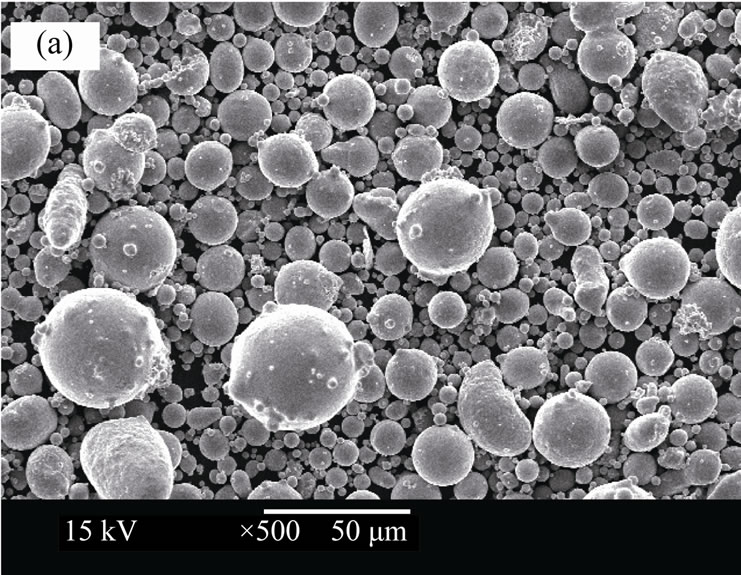

Figure 1. SEM images of raw commercial Fe91Si9 (a) and carbonyl-iron (b).
are spherical shape like an onion bulb, and the diameters are in the range of 1 - 10 µm, all the particles show the low degree of agglomeration.
3.2. EM Characteristics
The frequency dependence on the relative permittivity of the CIP, FSP and composite samples CF1, CF2, and CF3 are shown in Figure 2.
It is found that the values of the complex permittivity are sensitive to the content of FSP addition. Both the values of  and
and  decrease gradually with increasing weight percentage of FSP in the composites.
decrease gradually with increasing weight percentage of FSP in the composites.
For the CF1 composites, the values of  and
and  decline from 34.6, 13.1 to 28.5, 6.2 gradually with increasing frequency in the 2 - 7 GHz. For the CF2 composites, the values of
decline from 34.6, 13.1 to 28.5, 6.2 gradually with increasing frequency in the 2 - 7 GHz. For the CF2 composites, the values of  show less variation (
show less variation ( = ~23) and the values of
= ~23) and the values of  decline from 4.3 to 1.7 between 2 and 7 GHz. The values of
decline from 4.3 to 1.7 between 2 and 7 GHz. The values of  and
and  show almost constant over the whole measured frequency in the composites of CF3 (
show almost constant over the whole measured frequency in the composites of CF3 ( = ~14.5 and
= ~14.5 and  = ~1.4). According to free-electron theory [18],
= ~1.4). According to free-electron theory [18],  , where
, where ![]() is the conductivity. It can be found clearly that the sample
is the conductivity. It can be found clearly that the sample
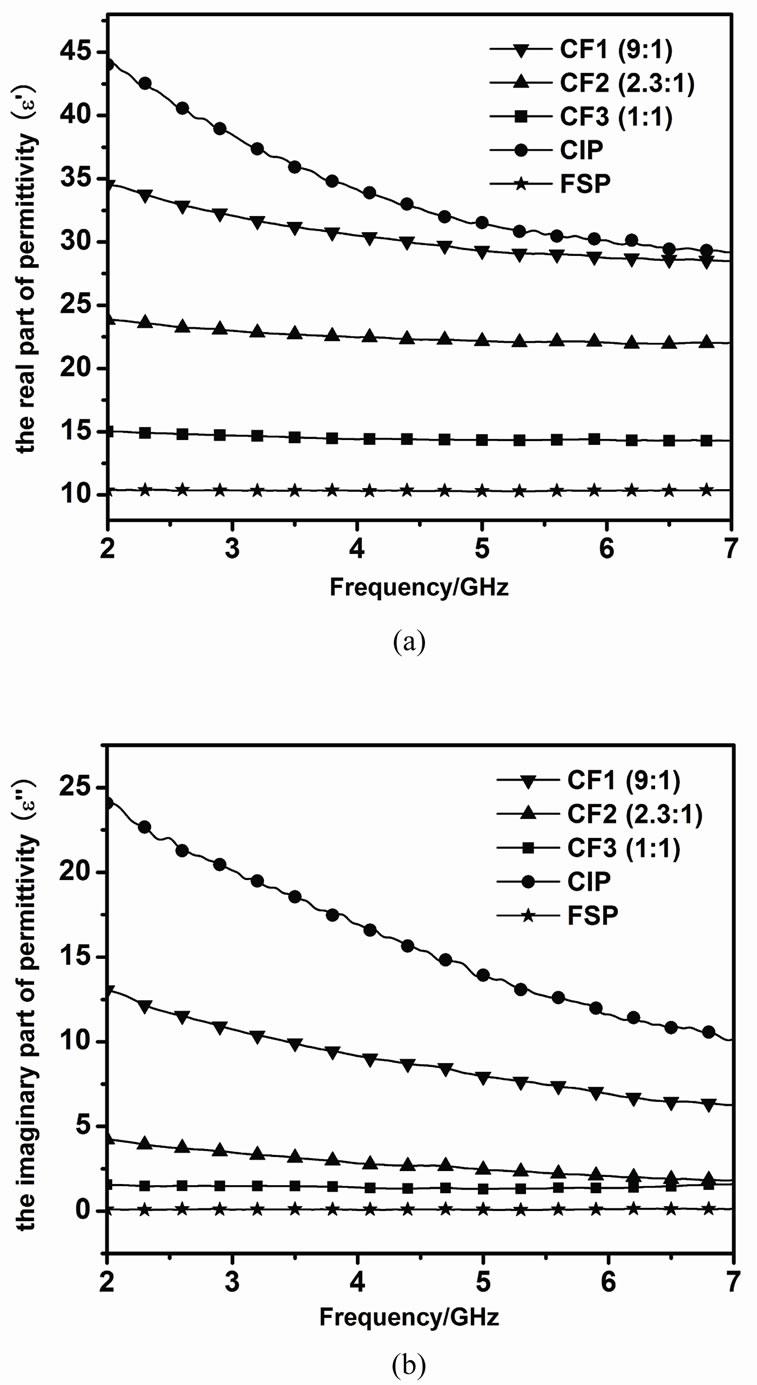
Figure 2. Frequency dependence on the relative permittivity, the real part  (a) and the imaginary part
(a) and the imaginary part  (b) of the carbonyl-iron, Fe91Si9 and carbonyl-iron/Fe91Si9 paraffin matrix composites with different weight ratios of carbonyl-iron to Fe91Si9.
(b) of the carbonyl-iron, Fe91Si9 and carbonyl-iron/Fe91Si9 paraffin matrix composites with different weight ratios of carbonyl-iron to Fe91Si9.
CF3 has higher resistivity than the samples CF1 and CF2.
The real part  and imaginary part
and imaginary part  of relative permeability of the CIP, FSP and composite samples CF1, CF2, and CF3 are plotted as a function of frequency in Figure 3.
of relative permeability of the CIP, FSP and composite samples CF1, CF2, and CF3 are plotted as a function of frequency in Figure 3.
It is obvious that  decreases gradually with increasing frequency, but
decreases gradually with increasing frequency, but  shows an increasing trend with increasing frequency. It is found that
shows an increasing trend with increasing frequency. It is found that  and
and  exhibit a linear variation as a function of the increasing addition of FSP. The changes in
exhibit a linear variation as a function of the increasing addition of FSP. The changes in  and
and  with the frequency for the composites obey the Lichitenecker’s logarithm mixed law [2],
with the frequency for the composites obey the Lichitenecker’s logarithm mixed law [2],
 (1)
(1)
where  and
and  are the normalized volume ratios of
are the normalized volume ratios of

Figure 3. Frequency dependence on the relative permeability, the real part  (a) and the imaginary part
(a) and the imaginary part  (b) of the carbonyl-iron, Fe91Si9 and carbonyl-iron/Fe91Si9 paraffin matrix composites with different weight ratios of carbonyl-iron to Fe91Si9.
(b) of the carbonyl-iron, Fe91Si9 and carbonyl-iron/Fe91Si9 paraffin matrix composites with different weight ratios of carbonyl-iron to Fe91Si9.
CIP and FSP, respectively. ,
,  and
and  are the complex permeability for the composite samples, CIP and FSP, respectively. Compared with CIP, FSP has lower
are the complex permeability for the composite samples, CIP and FSP, respectively. Compared with CIP, FSP has lower  and
and , so the addition of FSP will result in the decrease of relative permeability.
, so the addition of FSP will result in the decrease of relative permeability.
3.3. Microwave Absorption Properties
The RL of electromagnetic radiation under normal incidence of the electromagnetic filed on the surface of a single-layer material backed with a perfect conductor can be defined by [19]:
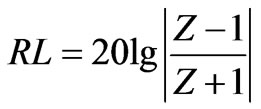 (2)
(2)
where, ![]() is the normalized impedance between input impedance
is the normalized impedance between input impedance  of the single-layered absorber and the impedance of free space
of the single-layered absorber and the impedance of free space , and is expressed as
, and is expressed as
 here,
here,  and
and ![]() represent the relative complex permittivity and the permeability of the composite medium, respectively, d is the thickness of an absorber, and
represent the relative complex permittivity and the permeability of the composite medium, respectively, d is the thickness of an absorber, and  is the wavelength of the incident wave in free space. Thus, the RL of an absorber is a function of six characteristic parameters, viz.,
is the wavelength of the incident wave in free space. Thus, the RL of an absorber is a function of six characteristic parameters, viz.,  ,
,  ,
,  ,
,  , f and d. The microwave absorption properties of the composites have been calculated from a computer simulation using (2) for various measured values of
, f and d. The microwave absorption properties of the composites have been calculated from a computer simulation using (2) for various measured values of ,
,  ,
,  ,
,  previously obtained. The calculated RL as a function of frequency for the samples with different thickness are shown in Figure 4.
previously obtained. The calculated RL as a function of frequency for the samples with different thickness are shown in Figure 4.
Figure 4 shows a typical relationship between RL and frequency for the paraffin matrix composites with 80 wt% CIP/FSP. Generally, “RL < –20 dB” is considered as adequate microwave absorption, as the RL value of –20 dB is comparable to 99% of microwave absorption according to (2). It is seen that the RL of carbonyl-iron and Fe91Si9 is very low and the peak values more than –20 dB in the frequency range of 2 - 7 GHz. The CF1 sample exhibits poor microwave absorption performance with the RL values more than –20 dB from 2 to 7 GHz, which may be due to the low EM impedance match between the high permittivity and relative low permeability. However, with increasing FSP content, microwave absorption is evidently improved. The RL values of the CF2 sample are less than –20 dB in the range of 2.0 - 3.5 GHz over absorbers thickness of 5.2 - 3.0 mm, and the optimal RL value is –33 dB at the frequency of 3 GHz with a matching thickness ( ) of 3.6 mm. The CF3 sample provides the best microwave absorption performances. The RL values of the CF3 sample less than –20 dB are obtained in the 3.7 - 6.7 GHz frequency range, with thickness of 4.0 - 2.4 mm, respectively. In particular, the optimal RL value of –45 dB is observed at 5.2 GHz with
) of 3.6 mm. The CF3 sample provides the best microwave absorption performances. The RL values of the CF3 sample less than –20 dB are obtained in the 3.7 - 6.7 GHz frequency range, with thickness of 4.0 - 2.4 mm, respectively. In particular, the optimal RL value of –45 dB is observed at 5.2 GHz with  of 3.0 mm. In order to make the results more clearly, the elec-
of 3.0 mm. In order to make the results more clearly, the elec-
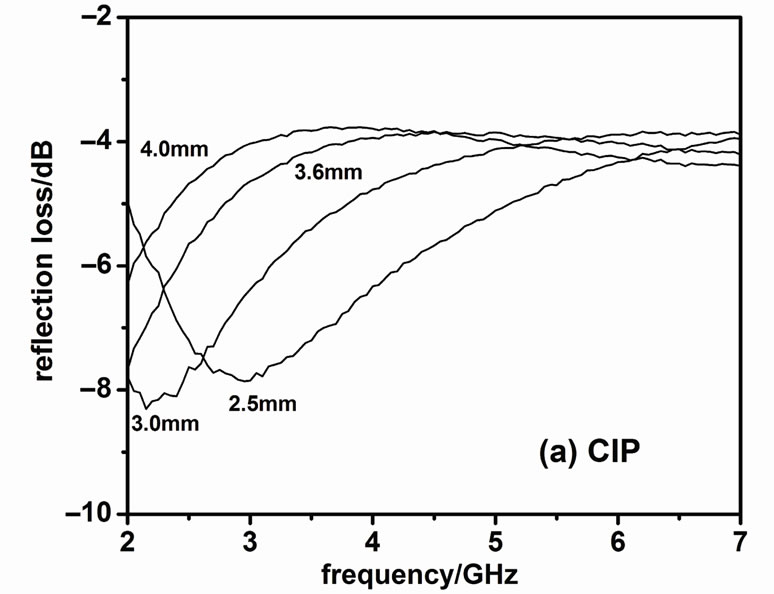

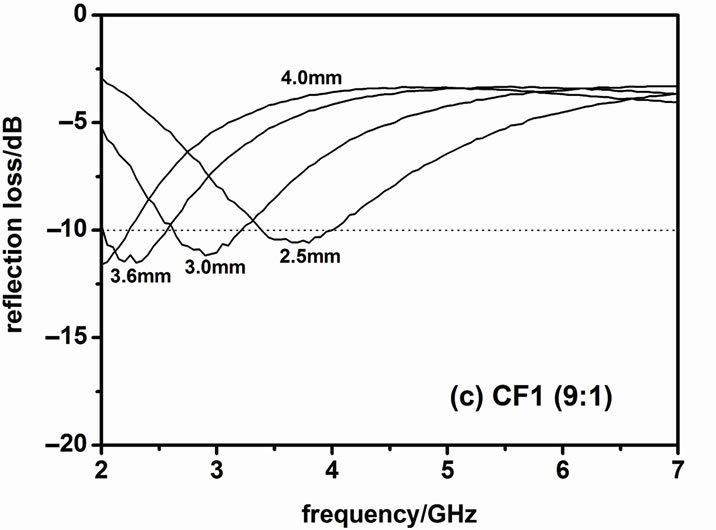
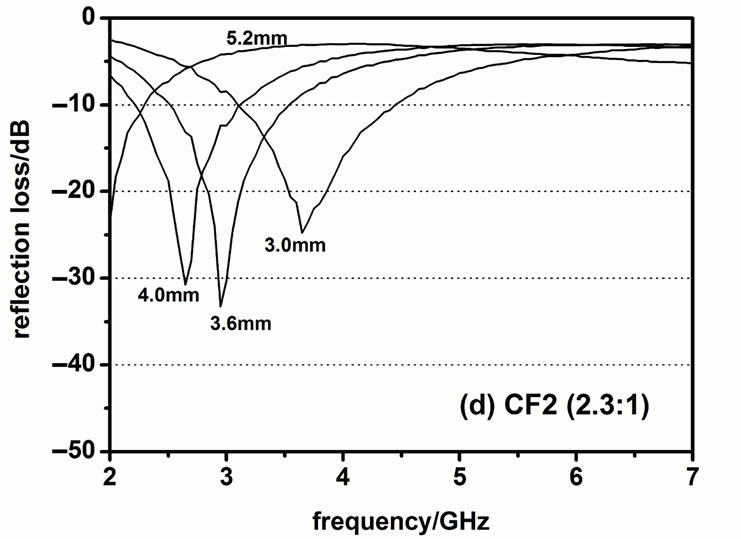
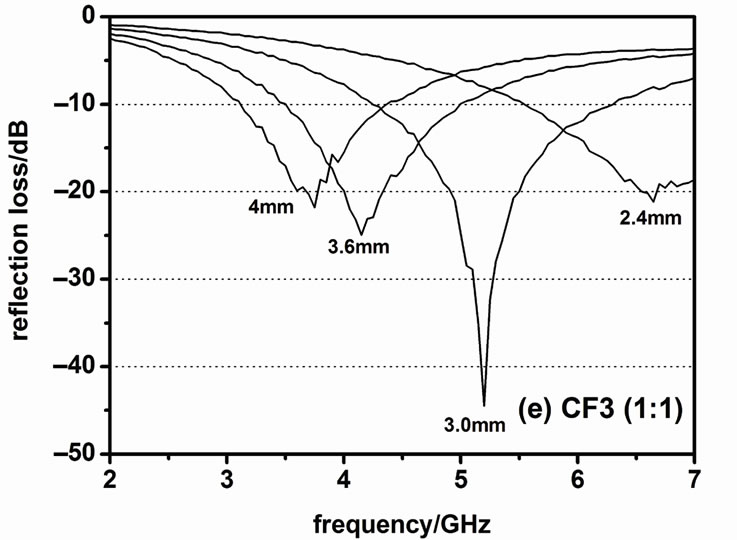
Figure 4. Frequency dependences of reflection loss values for the carbonyl-iron, Fe91Si9 and carbonyl-iron/Fe91Si9 paraffin matrix composites with different weight ratios of carbonyl-iron to Fe91Si9.

Table 1. Electromagnetic wave absorption properties of the carbonyl-iron/Fe91Si9 paraffin matrix composites with different weight ratios of carbonyl-iron to Fe91Si9.

Figure 5. Distribution of Fe91Si9 and carbonyl-iron powders in paraffin matrix.
tromagnetic wave absorption properties of the composite samples CF1, CF2, and CF3 prepared under the optimized conditions are summarized in Table 1.
It is clear that the frequency band of RL < –20 dB gets broader and the thickness gets thinner with increasing FSP content in the frequency range of 2 - 7 GHz. The improvement in microwave absorption of the composites with the addition of FSP is suggested to originate from the efficient combination of CIP and FSP. Generally, excellent EM-wave absorption results from efficient complementarities between the relative permittivity and permeability in materials. Either only the magnetic loss or only the dielectric loss may result in weak EM-wave absorption properties due to the imbalance of the EM impedance match [11]. The introduction of FSP to CIP weakens the dielectric loss, but has not weakened the magnetic loss too much. Thus, a better EM impedance match could be established due to the combination of the reduced dielectric loss and nearly invariable magnetic loss, resulting in the enhanced microwave absorption [6].
Figure 5 shows the distribution of FSP and CIP in the paraffin matrix. the FSP acts not only as a magnetic material, increasing the permeability of the composites powder, but also as an insulating matrix distributed among the gaps between carbonyl-iron particles, which could reduce the eddy current loss through increasing electric resistivity as an important reason bringing about the excellent microwave absorption [20].
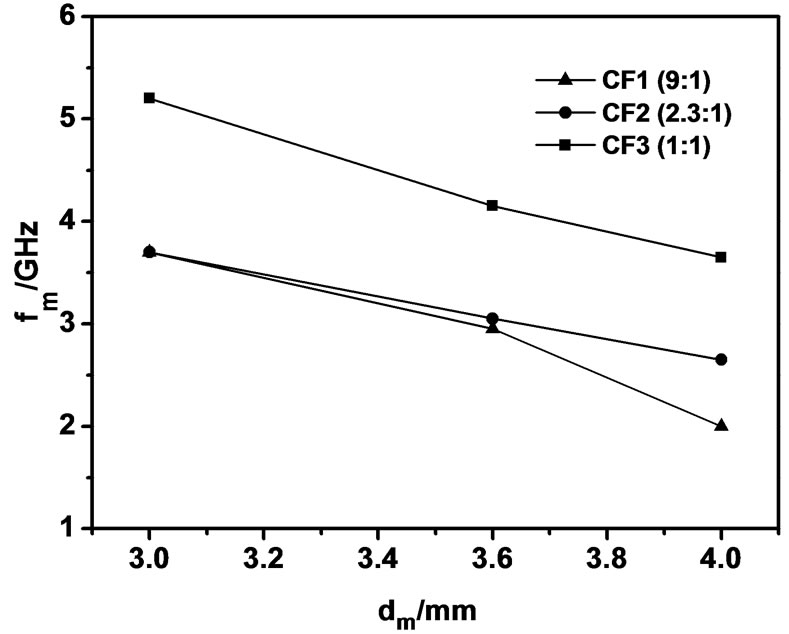
Figure 6. Relationship between matching frequency and matching thickness for carbonyl-iron/Fe91Si9 paraffin matrix composites with different weight ratios of carbonyl-iron to Fe91Si9.
The  and matching frequency (
and matching frequency ( ) for minimum reflection with thickness of 3.0 mm, 3.6 mm, and 4.0 mm, respectively, are indentified in case of the composite samples CF1, CF2, CF3 and their relationship is shown in Figure 6.
) for minimum reflection with thickness of 3.0 mm, 3.6 mm, and 4.0 mm, respectively, are indentified in case of the composite samples CF1, CF2, CF3 and their relationship is shown in Figure 6.
It is obviously that the matching frequency decreases with the increase of absorber thickness, but increases with increasing FSP content. This phenomenon is in consistent with (3) [21],
 (3)
(3)
where c is the velocity of light. The  become thinner quickly as a result of the phenomenon that
become thinner quickly as a result of the phenomenon that  shows an increasing trend with increasing frequency. It is significantly that the composite samples are very propitious to use in the 2 - 7 GHz frequency as one thin absorber.
shows an increasing trend with increasing frequency. It is significantly that the composite samples are very propitious to use in the 2 - 7 GHz frequency as one thin absorber.
4. Conclusions
In conclusion, the addition of FSP has remarkable effect on the complex permittivity, permeability and microwave absorption properties of the composites. Complex permittivity decreases quickly but permeability decreases slowly with increasing weight percentage of FSP in the composites. As a result of a better EM impedance match and a higher electric resistivity of FSP, the paraffin matrix composites with 80 wt% CIP/FSP exhibit excellent microwave absorption properties in the frequency range from 2 to 7 GHz. The RL values of the CF3 sample less than –20 dB are obtained in the 3.7 - 6.7GHz frequency range, with thickness of 4.0 - 2.4 mm, respectively. The optimal reflection loss reaches –45 dB is observed at 5.2 GHz with  of 3.0 mm. Therefore, the sample of CF3 is promising microwave absorber.
of 3.0 mm. Therefore, the sample of CF3 is promising microwave absorber.
5. Acknowledgements
The authors acknowledge the support from The Research Fund for the Doctoral Program of Higher Education of China (No.20090041120038), The Aero Science Foundation of China (20095463008), The Research Fund for the Advanced Research of the Weapon Equipment of China (No: 2009317).
REFERENCES
- L. G. Yan, J. B. Wang, Y. Z. Ye, Z. T. Hao, Q. F. Liu and F. S. Li, “Broadband and Thin Microwave Absorbers of Nickel-Znic Ferrite/Carbonyl-Iron Composites,” Journal of Alloys and Compounds, Vol. 487, No. 1-2, August 2009, pp. 708-711. doi:10.1016/j.jallcom.2009.08.051
- T. Kondo, T. Aoki, K. Asano and S. Yoshikado, “Fabrication of the Composites Electromagnetic Wave Absorbers,” International Symposium on Electromagnetic Compatibility, Vol. 19, Tokyo, June 1999, pp. 397-400.
- F. S. Wen, W. L. Zuo, H. B. Yi, N. Wang, L. Qiao and F. S. Li, “Microwave-Absorbing Properties of Shape-Optimized Carbonyl Iron Particles with Maximum Microwave Permeability,” Physica B, Vol. 404, No. 20, October 2009, pp. 3567-3570. doi:10.1016/j.physb.2009.06.001
- J. C. Aphesteguy, A. Damiani, D. DiGiovanni and S. E. Jacobo, “Microwave-Absorbing Characteristics of Epoxy Resin Composites Containing Nanoparticles of NiZnand NiCuZn-Ferrites,” Physica B, Vol. 404, No. 18, October 2009, pp. 2713-2716. doi:10.1016/j.physb.2009.06.065
- Y. X. Gong, L. Zhen, J. T. Jiang, C. Y. Xu and W. Z. Shao, “Preparation of CoFe Alloy Nanoparticles with Tunable Electromagnetic Wave Absorption Performance,” Journal of Magnetism and Magnetic Materials, Vol. 321, No. 22, November 2009, pp. 3702-3705. doi:10.1016/j.jmmm.2009.07.019
- Y. L. Cheng, J. M. Dai, D. J. Wu and Y. P. Sun, “Electromagnetic and Microwave Absorption Properties of Carbonyl-Iron/La0.6Sr0.4MnO3 Composites,” Journal of Magnetism and Magnetic Materials, Vol. 322, No. 1, January 2010, pp. 97-101. doi:10.1016/j.jmmm.2009.08.037
- J. R. Liu, M. Itoh and K. Machida, “GHz Range Absorption Properties of α-Fe/Y2O3 Nanocomposites Prepared by Melt-Spun Technique,” Chemistry Letters, Vol. 32, No. 4, 2003, pp. 394-396. doi:10.1246/cl.2003.394
- X. G. Liu, D. Y. Geng, H. Meng, P. J. Shang and Z. D. Zhang, “Microwave-Absorption of ZnO-Coated Iron Nanocapsules,” Applied Physics Letters, Vol. 92, No. 17, April 2008, pp. 173117-173117-3. doi:10.1063/1.2919098
- X. L. Dong, X. F. Zhang, H. Huang and F. Zuo, “Enhanced Microwave Absorption in Ni/Polyaniline Nanocomposites by Dual Dielectric Relaxations,” Applied Physics Letters, Vol. 92, No. 1, January 2008, pp. 013127- 013127-3. doi:10.1063/1.2830995
- X. G. Liu, D. Y. Geng, H. Meng, W. B. Cui, F. Yang, D. J. Kang and Z. D. Zhang, “Microwave Absorption Properties of FCC-Co/Al2O3 and FCC-Co/Y2O3 Nanocapsules,” Solid State Communication, Vol. 149, No. 1-2, January 2009, pp. 64-67. doi:10.1016/j.ssc.2008.10.015
- X. F. Zhang, X. L. Dong, H. Huang, Y. Y. Liu, W. N. Wang, X. G. Zhu, B. Lv, J. P. Lei and C. G. Lee, “Microwave Absorption Properties of the Carbon-Coated Nickel Nanocapsules,” Applied Physics Letters, Vol. 89, No. 5, August 2006, pp. 053115-053115-3. doi:10.1063/1.2236965
- A. Butera, J. N. Zhou, J. A. Barnard, “Standing spin waves in granular Fe-SiO2 thin films,” Journal of Applied Physics, Vol. 87, No. 9, May 2000, pp. 5627-5629. doi:10.1063/1.372471
- Q. L. Liu, D. Zhang and T. X. Fan, “Electromagnetic Wave Absorption Properties of Porous Carbon/Co Nanocomposites,” Applied Physics Letters, Vol. 93, No. 1, July 2008, pp. 013110-013110-3. doi:10.1063/1.2957035
- J. R. Liu, M. Itoh and K.Machida, “Magnetic and Electromagnetic Wave Absorption Properties of α-Fe/Z-Type Ba-Ferrite Nanocomposites,” Applied Physics Letters, Vol. 88, No. 6, February 2006, pp. 062503-062503-4. doi:10.1063/1.2170402
- Z. Schlesinger, Z. Fisk, H. T. Zhang and M. B. Maple, “Is FeSi a Kondo Insulator?” Physica B, Vol. 237-238, July 1997, pp. 460-462. doi:10.1016/S0921-4526(97)00137-3
- Y. C. Qing, W. C. Zhou, F. Luo and D. M. Zhu, “Electromagnetic and Microwave Absorption Properties of Carbonyl Iron and Carbon Fiber Filled Epoxy/Silicone Resin Coatings,” Applied Physics A, Vol. 321, No. 4, 2009, pp. 1177-1181.
- L. D. Liu, Y. P. Duan, S. H. Liu, L. Y. Chen and J. B. Guo, “Microwave Absorption Properties of One Thin Sheet Employing Carbonyl-Iron Powder and Chlorinated Polyethylene,” Journal of Magnetism and Magnetic Materials, Vol. 322, No. 13, July 2010, pp. 1736-1740. doi:10.1016/j.jmmm.2009.12.017
- A. Wadhawan, D. Garrett and J. M. Perez, “Nanoparticle-Assisted Microwave Absorption by Single-Wall Carbon Nanotubes,” Applied Physics Letters, Vol. 83, No. 13, August 2003, pp. 2683-2685.
- Y. P. Duan, H. Ma, X. G. Li, S. H. Liu and Z. J. Ji, “The Microwave Electromagnetic Characteristics of Manganese Dioxide with Different Crystallographic Structures,” Physica B, Vol. 405, No. 7, April 2010, pp. 1826-1831. doi:10.1016/j.physb.2010.01.055
- B. W. Li, Y. Shen, Z. X. Yue and C. W. Nan, “Ehanced Mocrowave Absorption in Nickel/Hexagonal-Ferrite/ Polymer Composites,” Applied Physics Letters, Vol. 89, No. 13, September 2006, pp. 132504-132504-2. doi:10.1063/1.2357565
- T. Maeda, S. Sugimoto, T. Kagotani, N. Tezuka and K. Inomata, “Effect of the Soft/Hard Exchange Interaction on Natural Resonance Frequency and Electromagnetic Wave Absorption of the Rare Earth-Iron-Boron Compounds,” Journal of Magnetism and Magnetic Materials, Vol. 281, No. 2-3, October 2004, pp. 195-205. doi:10.1016/j.jmmm.2004.04.105

